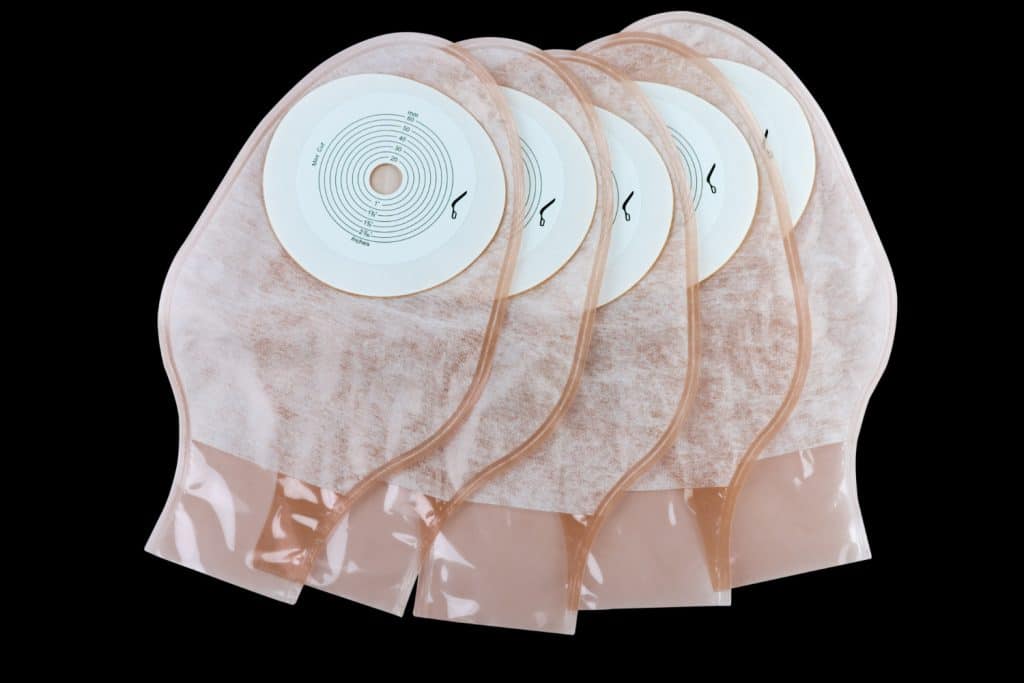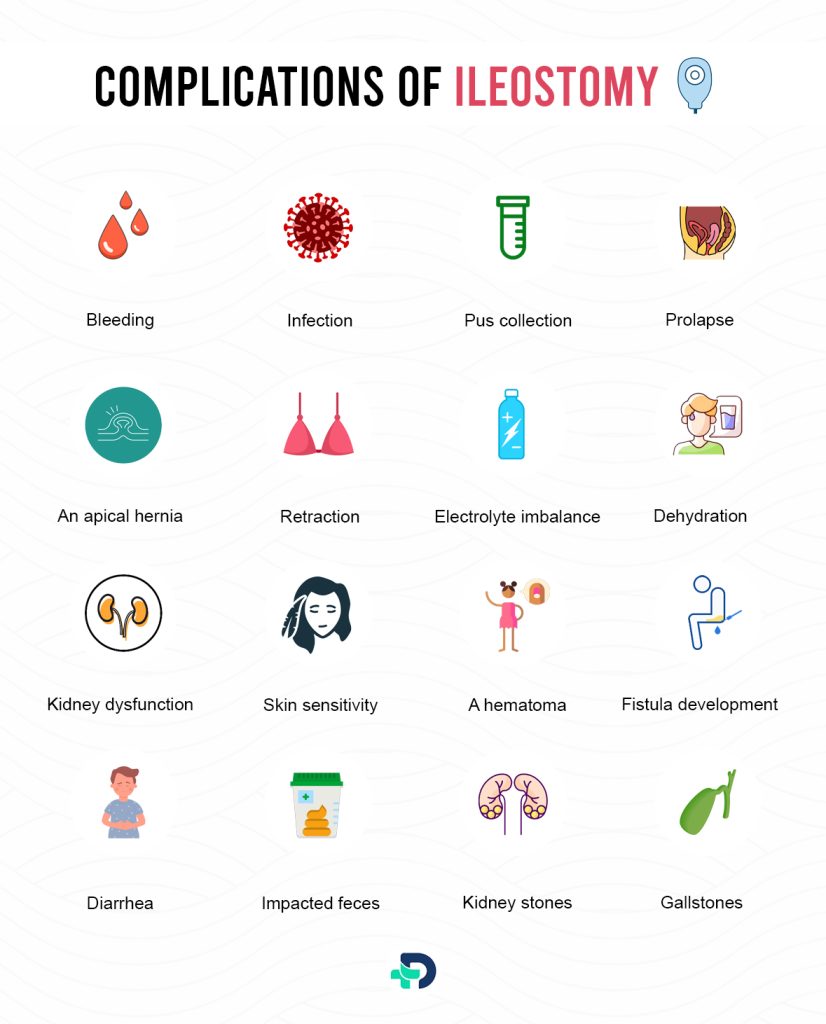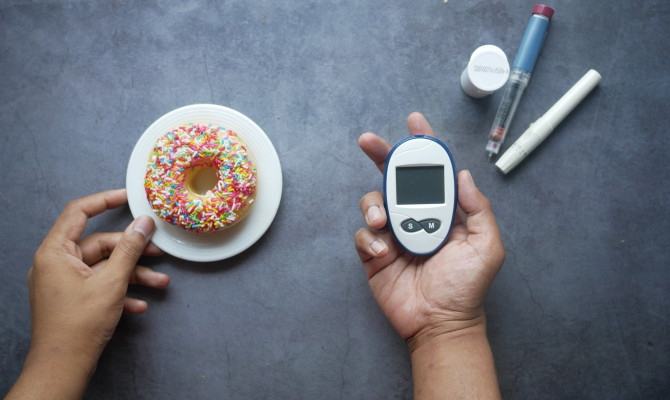Living with Ileostomy – A Guide to Adjusting and Thriving

- Ileostomy
- 28 Aug 2023
Overview
Introduction:
An ileostomy removes stool from the body through the ileum instead of the usual anal route. An ileostomy may save a patient’s life. Maintaining an ileostomy can require a significant shift in lifestyle. Individuals may need weeks, months, or even years to get used to their ostomy appliance. A general surgeon, pediatrician, or colorectal surgeon often performs an ileostomy. The forma ion of an ileostomy can be viewed as an accessory to a life-saving surgical approach, whether done on an elective basis or as an emergency.
This article explains the Ileostomy’s indications, contraindications, surgical procedures, and complications while highlighting the need for an interprofessional team in treating patients with stomas.

Ileostomy
What Is Ileostomy?
- An ileostomy is a surgical procedure that enables stool to leave the body.
- An ileostomy is made by cutting a piece of the small intestine’s ileum.
- The duodenum proximally, ileum distally, and ileum are the three adjacent portions that make up the small intestine, which starts at the pylorus of the stomach.
- The small intestine performs various functions like nutrition absorption, enzyme and protein secretion, and food digestion. 1Ileostomy| Researched based study from National Library of Medicine
- To lessen the chance of eventual parastomal hernia formation, which happens when the abdominal contents push through the weakness caused by the incision, an ileostomy should be delivered through the rectus sheath and muscle. 5Ileostomy | Researched based study from National Library of Medicine
What Is Loop Ileostomy?
- A loop ileostomy is created using the two ends of the small bowel.
- It was anticipated that this would only last a short time and that the gut ends would eventually reattach. Then, the bowels will open normally.
- In loop ileostomies, the proximal limb is used to expel stool.
- This is significant to remember since the patient would be in danger of perforation from a significant bowel obstruction if there were a colonic obstruction. 1Ileostomy| Researched based study from National Library of Medicine
What Is End Ileostomy?
- After permanently removing the entire colon, installing an end ileostomy is typically contemplated.
- Later, the patient is responsible for maintaining the stoma for the rest of their life. 1Ileostomy| Researched based study from National Library of Medicine
Indications
Indications for Ileostomy:
Some of the ailments that might necessitate an ileostomy or colostomy are:
- Intestinal infections
- An intestinal infection – Diverticulitis
- Crohn’s illness
- Cancerous bowel
- Ulcerative colitis
- Obstructed bowel
- Higher risk for developing cancer like familial adenomatous polyposis
- Gastrointestinal harm that is severe 2Indications | Researched based study from Better Health
Considerations
Things to Consider Before Ileostomy Surgery:
One must consult the doctor before the surgery for the following:
- Medical background.
- All medications the person usually takes or is currently taking include herbal supplements, over-the-counter medicines, vitamins, and nutritional supplements.
- Any worries the person has regarding appearance, cleanliness, or sexuality.
- Potential risks and problems of the procedure. 2Considerations| Researched based study from Better Health
Preparation
Preparation of Ileostomy Surgery:
Before having surgery for an ileostomy, one must undergo surgery to remove the rectum and colon or just a part of the small intestine. Later depending on the surgery being performed and whether it is an emergency or elective procedure, the patients are asked to follow a few instructions mentioned below:
- Hair removal from the abdominal wall
- To lose weight to increase their anesthetic compatibility
- Rehydration with enough liquids and electrolytes 3Preparation | Researched based study from MedlinePlus
Procedure
Ileostomy Surgery Procedure:
Ileostomy and colostomy surgery are comparable procedures. The process ure includes:
- The bowel is prepared through a liquid diet and special cleansing and antimicrobial drugs, except for emergency surgery.
- The patient will be administered general anesthesia.
- On the abdomen, the surgeon makes a mark. The lower right side of the abdomen is a frequent location.
- The abdomen has been exposed.
- The affected intestinal segment is cut off. The healthy piece is then removed by making a little abdominal incision (stoma).
- The section of healthy bowel is stitched to the stoma.
- To collect waste, a plastic bag is placed over the stoma.
- Stitches are used to seal the significant abdominal incision. 2Procedure | Researched based study from Better Health
After the procedure, one can expect the following:
- For a few days, one will receive an intravenous infusion into the arm.
- Later, they will insert a tiny tube into the stomach to remove its contents so that the intestines can recuperate from surgery and relax.
- The wound’s dressing will likely need to be changed regularly for the first few days to maintain the wound clean and prevent contamination.
- One can begin eating light when the tube entering the stomach is taken out.
- The stoma will eventually allow the feces to pass.
- In five to six days, the sutures might be taken out.
- If the wound has not fully healed, one can take a bath after a few days with a bag covering the stoma. Or they can take a bath without covering the stoma if the wound has healed.
- One week of hospitalization will be required. 2Procedure | Researched based study from Better Health
Complications

Complications of Ileostomy:
Immediate, early, or late problems and procedure-specific and general complications can all be categorized. It is significant to highlight that 20% of people develop difficulties after having an intestinal stoma created. The following are complications to the procedure: 1Complication | Researched based study from National Library of Medicine
- Bleeding
- Infection
- Pus collection
- Prolapse
- An apical hernia
- Retraction
- Electrolyte imbalance
- Dehydration
- Kidney dysfunction
- Skin sensitivity
- A hematoma
- Fistula development
- Diarrhea
- Narrowing of the stoma
- Difficulty passing stool through the stoma and into the bag
- Allergic reaction to surgical drugs like anesthesia
- Incisional hernia (Bowel protruding through the stoma)
- Blockage of the stoma, which is because of scar tissue
- Impacted feces
- Kidney stones
- Gallstones 1Complication | Researched based study from National Library of Medicine
Contraindications
Contraindications for Ileostomy:
Ileostomy formation is not absolutely contraindicated, although there are several precautions, such as:
- The ileum cannot be externalized through the abdominal wall to the skin without stress due to a short mesentery. Unfortunately, overweight patients are more likely to experience this. The Ileostomy should be created as far distally as possible to allow ample intestinal length for nutrient absorption.
- A high-output ileostomy can cause malabsorption, which can result in malnutrition, as well as electrolyte imbalances, which are crucial to monitor and manage in patients with renal impairment.
- Spouting the stump is crucial during ileostomy formation to keep the effluent away from the skin.
- To allow for the placement of the stoma appliance and prevent leakage, an ileostomy should be placed away from scars, skin wrinkles, and bony prominences. 1Contraindiction| Researched based study from National Library of Medicine
Lifestyle Adjustments
Taking Care at Home After Ileostomy – Lifestyle Adjustments:
- One can get advice from a therapist about the various colostomy bag types, skin sealants, powders, and skin barriers they should use.
- Keep the skin around the stoma adequately cleaned.
- To prevent constipation, one must rinse the stoma with water. Intake of small, frequent meals.
- Limit intake of foods like onion, cabbage, beans, and carbonated beverages.
- Avoiding behaviors that induce air to be swallowed, including smoking, chewing gum, and sipping through a straw, are all ways to prevent gas buildup and excessive odors.
- To lessen odor, try charcoal tablets or anti-flatulent remedies.
- Foods with strong odors, such as eggs, seafood, asparagus, and cheese, should be consumed in moderation.
- For the first few months, consume a low-residue diet to ease the strain on the bowels and stoma.
- Avoid celery seeds and popcorn.
- There are no dietary limitations once fully healed (generally three months following surgery). 2Lifestyle Adjustments | Researched based study from Better Health
Prognosis
Prognosis:
The majority of people with ileostomies are able to engage in most of their normal activities. This encompasses the majority of gardening, sports, hiking, and other outdoor events, as well as going out for their jobs. One could require continuing medical care if one has a chronic condition like ulcerative colitis or Crohn’s disease. This surgery is performed in the patient’s best interests to help preserve their life and enhance their quality of life. It is imperative to emphasize to patients that even with an ileostomy, it can still be possible to live a normal life and carry on with regular activities. 1Prognosis| Researched based study from National Library of Medicine 4Prognosis| Researched based study from MedlinePlus
Any feedback on this article?
 This Articles content was accurate
This Articles content was accurate Very Informative Article
Very Informative Article I have a question or a comment
I have a question or a comment
 This article contains inaccurate content
This article contains inaccurate content This article was not helpful
This article was not helpful I have a question or a comment
I have a question or a comment
We appreciate your helpful feedback!
Checkout our social pages
References
-
National Library of Medicine
Ileostomy | Indications | Preparation | Complications | Contraindications | Prognosis
-
Better Health
Indications | Procedure | Lifestyle Adjustments | Considerations
-
MedlinePlus
Ileostomy | Preparation | Procedure
-
MedlinePlus
Prognosis
-
National Library of Medicine
Ileostomy | Introduction




































